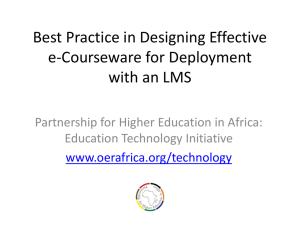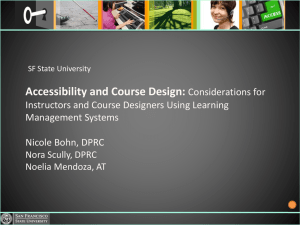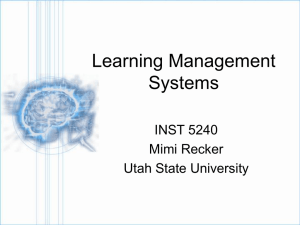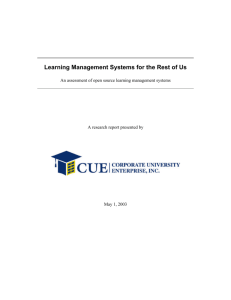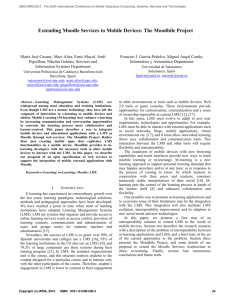PVAMU Open Source Software and Converge Communications
advertisement
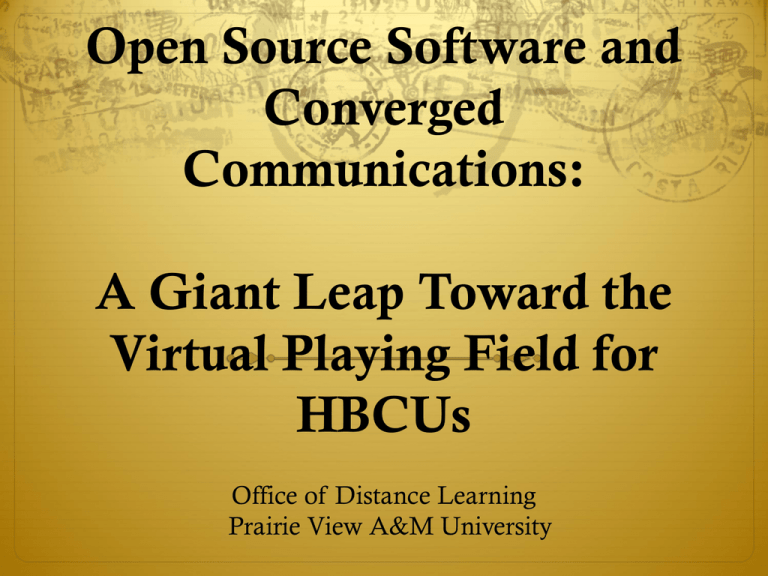
Open Source Software and Converged Communications: A Giant Leap Toward the Virtual Playing Field for HBCUs Office of Distance Learning Prairie View A&M University Abstract The HBCU community has not historically ridden the cutting edge of new information technologies. They were not among the first adopters of mainframe computing in the 60’s and 70’s and were not in the first wave of microcomputer and internet adopters in the 80’s and 90’s. The advent of the third millennium provided an opportunity for HBCUs to shine as the new internet browser and server technologies provided a level platform for presenting webbased information sets on the small screen video monitor. Abstract (cont.) This second decade of the third millennium presents another opportunity for technological leadership by the HBCU community. Open source software coupled with converged communications allows low-cost scalable access to diverse communities of learners and community builders. The experience of Prairie View A&M University with the Open Source LMS, Moodle, and Polycom’s RealPresence® Platform will be highlighted in this overview of information technology development. Prologue Prairie View A&M University has installed a communications infrastructure to support video communications across the enterprise. Prairie View A&M University has also completed the treacherous journey associated with the move from one Learning Management System (LMS) to another. Just when you think you’ve got everything figured out, flying monkeys come out of nowhere. However, from the work of a committed team with support from a dedicated faculty, a sensitive administration, and concerned students has come a LMS that will support course delivery, institutional assessment, and ePortfolio development. Communications Infrastructure Prairie View A&M University has installed a communications infrastructure that includes the following elements: Polycom RMS 2000 – A multi-point Conferencing Platform to allow collaboration or course sharing across the University. Polycom RSS 4000 – A centralized application for video content recording, streaming, and archiving of multimedia conferences Polycom CMA 4000 – A centrally managed resource to deploy visual communications across the entire University— from large conference rooms to individual desktops. Follow, Follow, Follow Getting to the Land of OZ The changes to our current LMS and our last SACS visit formed the cyclone that caused us to somehow end up in the land of OZ. Getting to the Land of OZ Our current learning management system (LMS) vendor was making changes to the product and to the pricing structure. Also, after the SACS visit was successfully concluded in March 2010, we found that we were on the right track with our assessment system but needed to tweak it. Unfortunately, our assessment system was being sunset by the vendor. As a result, we decided to look for products that combined assessment with a LMS. Getting help from the Good Witch of the North The Good Witch put us on the path to the Wizard by showing us the Yellow Brick Road. Getting help from the Good Witch of the North University Administration allowed flexibility and freedom to explore multiple potential solutions. During this exploration, various groups looked at staying with our current LMS, other proprietary LMS’s, and open source LMS’s. Confronting Obstacles Thrown by Wicked Witch The Wicked Witch sent flying monkeys during our journey, but we found our way. Confronting Obstacles Thrown by Wicked Witch During the analysis of assessment packages, there were several occasions when we were lured from the gilded path by products that appeared to be ideal solutions. Upon deeper investigation, we found that those solutions were not acceptable for various reasons (primarily cost and flexibility) and we ended up working our way back to the Yellow Bick Road. Finding the Wizard After trekking through the treacherous Land of Oz, we eventually found the Wizard. Finding the Wizard Various focus groups worked with our Instructional Designers to analyze multiple products before finally settling on four: MOODLE (open source) Sakai (open source) ANGEL (Proprietary, but subsequently purchased by BlackBoard) Blackboard Learn (Proprietary, current system) Finding the Wizard After an extended review process, the university approved MOODLE as the replacement for the current LMS and the sunset assessment product. What is MOODLE and why was it chosen? Modular Object-Oriented Dynamic Learning Environment Open source Free Highly scalable and customizable Users have a great deal of input in system development User friendly Simple, easy-to-follow layout for designers, instructors, and students Straightforward user interface Getting back to Kansas The Wizard had told us what we need to do in order to get home. Getting back to Kansas After the product was identified that would serve as our LMS and assessment system, it had to be put it in place. Implementation overview: Identified a hosting organization to assist with the migration and management. Integrated MOODLE with the BANNER student information system. Added the blocks and modules necessary to complete the assessment piece. Added additional staff. MOODLE Implementation Full featured Learning Management System Integrated with BANNER and University Active Directory Turnitin License added for plagiarism detection Respondus License added for quiz/exam generation SoftChalk License added for enhanced course web production CourseCast License added for Lecture capture and video archival New look of eCourses New look of eCourses New look of Outcomes New look of Outcomes New look of Outcomes New look of Outcomes Office of Distance Learning Dr. John R. Williams - Director Charlene Stubblefield – Senior Instructional Designer/Trainer Major Stewart – Instructional Designer/Trainer Stephanie Holmes – Instructional Designer/Trainer Samuel Adams – Network Manager Carl Taylor – Telecommunications Manager Lenora Taylor – Administrative Assistant This is not THE END IT IS THE Beginning!


